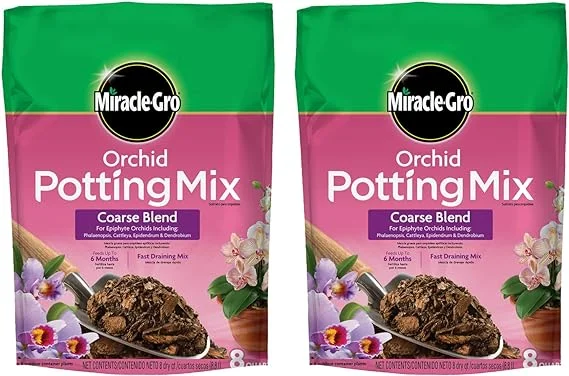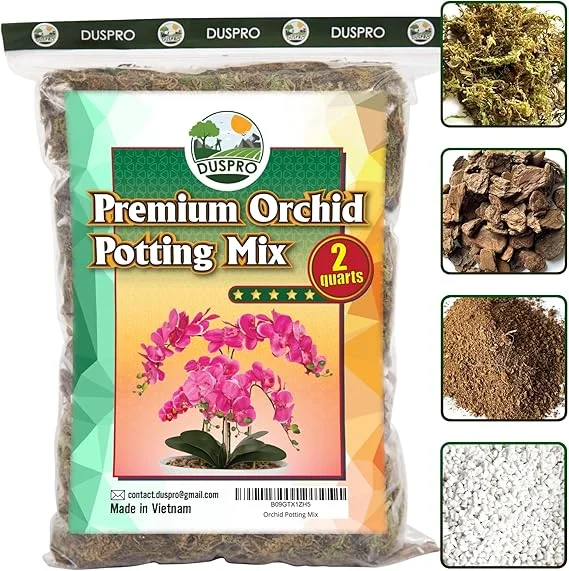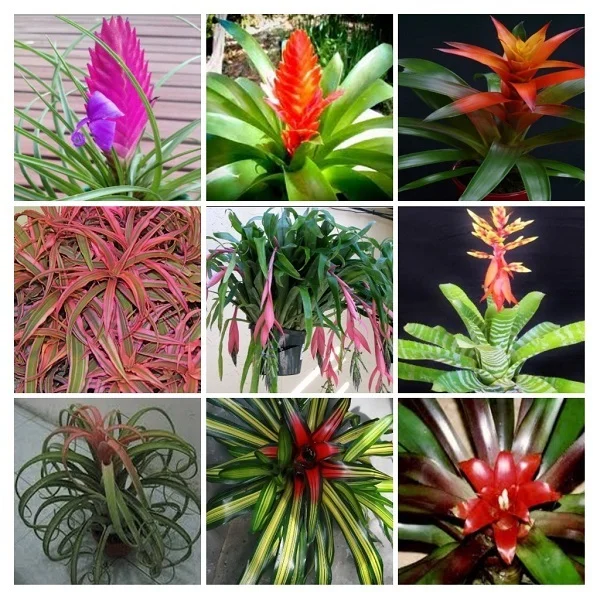Moth Orchids (Phalaenopsis Orchids) Indoor Care, Propagation and Common Problems
Some links in this post may be affiliate links
Moth Orchids (Phalaenopsis Orchids) bloom in bright indirect light, moderate warmth, above average humidity and moderately moist, rich, well-aerated, orchids potting soil coupled with regular feeding in the growing period.
Phalaenopsis Orchids also called Phals are some of the popular orchids with flat-faced, fragrant, long-lasting flowers on a stem that branches near the end.
The flower sepals and petals are all free and widely apart from each other. The petals are are much wider than the sepals. The lip (lowermost petal) is significantly different from the other petals and has three lobes.
Several of these flat-faced flowers blooming along an arching stem look like moths in flight and hence the common name, 'moth orchid'.
Moth Orchids are monopodial which grow from a single point, they add leaves to the apex each year and the stem grows longer accordingly. They have long-coarse roots and short, leafy stems hidden by overlapping leaf bases; they do not have pseudobulbs.
The leaves in Moth Orchids are dark-green on top with streaks of red or burgundy on the the undersides. They are usually arranged in two rows, relatively large and leathery, oblong and sometimes succulent.
The genus name, Phalaenopsis is derived from the Greek word phalaina meaning "a kind of moth" in reference to the moth-shaped flowers. The genus name, Phalaenopsis is abbreviated as "Phal" in horticultural journals.
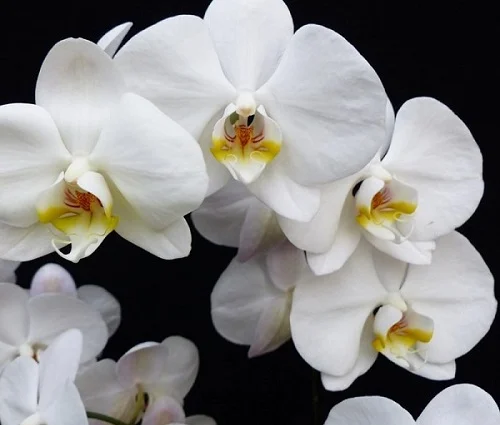
Botanical name: Phalaenopsis
Family: Orchidaceae
Subfamily: Epidendroideae
Tribe: Vandeae
Subtribe: Aeridinae
Common names: Moth Orchid, Phals
Origin
Phalaenopsis is a genus of orchids occurring in the wild from tropical to subtropical Asia with the majority in Indonesia and Philippines where they grow on trees.
Varieties
Many hybrids and cultivars of Phalaenopsis Orchids have been developed. Flowers are available in red, white, pink , yellow and purple and sometimes spotted and often with a contrasting lip and veins.
Is Moth Orchid toxic?
Moth Orchids are non-toxic to both humans and pets. They are safe to grow indoors.
Where to Buy
If looking to add Moth orchids to your collection, they are readily available online on Etsy (Link to Etsy).
Phalaenopsis Orchid Care Indoors
Moth Orchids (Phalaenopsis Orchids) flourish in bright indirect light, moderate warmth of 16-290C, humidity of 60-70% and moderately moist, fertile, well-aerated, orchids potting soil coupled with regular feeding during the growing period.
Phalaenopsis Orchid requires regular pruning to keep them neat as well as encourage flowering. Repotting is needed only when they become pot-bound or the soil becomes completely broken down. Keep on reading for more on these growing conditions and how to provide them.
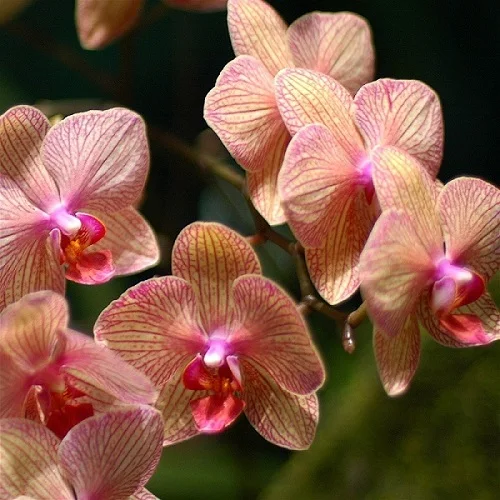
Light requirements
Moth Orchid grows best in bright indirect light of about 10 hours per day. Keep it away from direct sunshine to avoid sun scorch on the leaves.
A Moth Orchid that is receiving the right amount of light has dark-green leaves. Yellowish leaves means that the orchid is receiving too much light.
If the natural light is inadequate, you may grow Phalaenopsis Orchid under grow lights. Check out these full spectrum grow lights on Amazon.
Regularly turn the pot to ensure that the Orchid receives adequate light on all sides for uniform growth.
Watering
Water Moth Orchid thoroughly during the growing season and allow the top half of the soil to dry out between waterings to keep the soil moderately moist. Decrease watering in the cold period as growth is minimal at this time to keep the soil slightly moist but do not let it dry out completely.
To take the guesswork out of watering a Phalaenopsis Orchid, check the roots. Whitish-green and plump roots indicate that the Orchid is well hydrated. Whitish-silvery, thin roots indicate the Orchid needs to be watered.
Use water that is at room temperature to avoid shocking this tropical plant as it can lead to reduced growth. Phals are sensitive to chlorine and other chemicals dissolved in water, therefore, water with chlorine-free water only.
Avoid wetting the foliage as it can lead to fungal diseases. Water the orchid from the bottom instead. Should you wet the foliage, dry it by wiping with a dry soft cloth.
Phalaenopsis Orchids unlike Brassia (Spider) Orchids are less tolerant of dry soil conditions due to the absence of pseudobulbs, therefore, they cannot tolerate long periods of dryness.
Temperature and Humidity
The best temperatures for Moth Orchid are between 16-290C. The warmer days and cooler night temperatures with a difference of 10-150C are ideal. The cool nights are essential to trigger flowering.
Keep the orchid away from drafts to avoid sudden changes in temperature which can negatively affect the growth of the orchid
Humidity of 60-70% is ideal for Phalaenopsis Orchids. Where the air is too dry, set the pot on a wet pebble tray or use a cool mist humidifier to up humidity. Read more on how to raise humidity for houseplants.
Do not mist the orchids as misting encourages fungal disease infestations. Occasionally clean the leaves by damp-wiping with a soft cloth to get rid of dust as well as discourage pests and diseases.
Ensure that there is good air circulation as these orchids cannot tolerate hot and stuffy conditions which can cause disease infestations.
Potting Medium
The best potting medium for Moth Orchids should be loose, free-draining, bark mix to avoid getting soggy soil which can cause rotting.
Fertilizer
Feed Moth Orchid during the growing season with an orchid's fertilizer as per the manufacturer's instructions. Do not feed in the cold season as growth is minimal at this time. Do not feed an orchid that is in flower as it can shorten the flowering period.
It is better to err on the side of underfeeding than overfeeding as overfeeding can result in loss of the roots thus death of the orchid. If you overfeed, it can also lead to vegetative growth at the expense of flower production.
Repotting
Repot Moth Orchid only when growth begins to suffer which is when the lower leaves begin to die as it blooms best when it is pot-bound. Basically repotting a Moth Orchid every 2 years should be adequate. Repot it only when new growth begins, shortly after blooming is over.
Do not repot an orchid that is in flower as it may shorten the flowering season. Use a pot with proper drainage holes or slits as the roots of the orchid need good air circulation. The pot should be only 1 size larger than the current one.
While repotting, remove all the soil from around the stems and roots. Remove any dead and dying leaves from the bottom as they are breeding ground for pests and diseases. Remove dead roots to create space for the growth of new roots.
Thereafter, water the orchid thoroughly and ensure that both the soil and the roots absorb all the water they need. Check out these orchid pots with a free slotted orchid pot liner on Amazon.
Pruning
Pruning Moth Orchid is easy. Remove dead and diseased leaves to keep it neat and reduce pests and diseases. Cut them at the base with sharp scissors or a knife. When flowering is over, cut the flower stalk 1 inch above the 3rd node from the bottom to encourage more flowering.
Propagation
Phalaenopsis Orchids (Moth Orchids) propagation can be done at the beginning of the growing season from keikis (baby orchids). These orchids naturally produce "baby" orchids called "keiki" which normally appear on an old or new flower spike or at the base of the orchid.
Keikis are identical copies of the parent plant. Keiki growth can be triggered by prolonged exposure to high temperature during the final phase of spike growth.
How to propagate Moth Orchid from keikis
The keiki can be detached from the mother Moth Orchid when about one year old when it has developed 2-3 leaves and 1-3 inch long roots.
Pot the keiki in fresh potting medium. Direct the roots of the keiki downwards and provide support for the keiki.
Place the set up in a well-lit, warm place and mist the keiki regularly to maintain a humid enviroment.
The Phalaenopsis Orchid keiki may take 6-12 months to bloom.
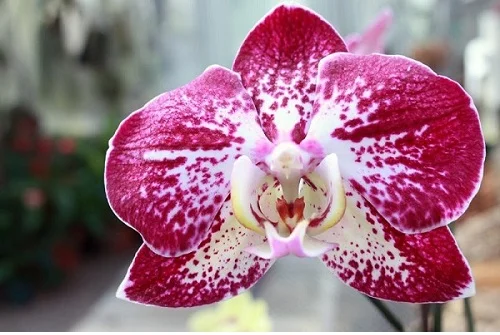
Phalaenopsis Orchids Problems with Solutions
Moth Orchids (Phalaenopsis Orchids) growing problems include black leaf tips, lack of blooms, mold, drooping leaves, leaf spots, discolored leaves, pests and diseases among others. Keep reading for more on these problems and how to fix them.
Pests
Common pests in Moth Orchids are mealy bugs, scales, slugs and snails. Isolate the affected orchid to prevent spread to other plants and treat it with neem oil as per the manufacturer's recommendations.
Lack of blooms
One possible reason for lack of blooms in Moth Orchid is too little light. Place the orchid in a brighter spot and ensure it is receiving bright indirect light or instal grow lights if the natural light is not adequate. Check out this guide on understanding light for houseplants.
The second possible reason for lack of blooms in Phalaenopsis Orchid is overfeeding which can result in vegetative growth at the expense of flowers production. Feed the orchid during the growing season with an orchid's fertilizer as per the manufacturer's instructions. Do not feed in the cold season. Learn how to feed houseplants.
Mold on the leaves
Mold on the leaves in Moth Orchid is an indication of powdery mildew which is promoted by damp conditions coupled with poor air circulation.
Misting or wetting the foliage of the orchid can lead to mildew growth if the water does not evaporate quickly due to poor air circulation. Improve ventilation to make sure that there is good air circulation for the orchid and stop misting it or wetting the foliage during watering.
Brown soft leaf spots
Brown soft leaf spots in Moth Orchid are an indication of leaf spot disease and is prevalent in damp, stuffy conditions. Remove the affected leaves immediately to prevent further spread and improve air circulation.
Brown and hard dry leaf spots
Exposure of Moth Orchid to direct sunshine will result in scorch marks which are brown and hard dry spots on the leaves. Move the orchid to a shadier spot where it will receive bright indirect light or protect it from hot direct sunshine.
Limpy and drooping leaves
Limpy and drooping leaves in Moth Orchid are caused by underwatering. Keep the soil moderately moist and do not allow the soil to dry out completely. Water the orchid liberally during the growing season while allowing the top half of the soil to dry out between waterings to maintain the soil moderately moist.
Cut down on watering in the cold period and keep the soil slightly moist as the growth is minimal. Do not allow the soil to dry out completely. Learn more on how to water houseplants correctly.
Yellowish leaves
Yellowish leaves in Moth Orchid indicate that the orchid is getting too much light. Move the orchid to a shadier spot. The leaves of a Phalaenopsis Orchid that is receiving bright indirect light should be dark-green.
Leaf tips turning black and dying
The cause of black leaf tips in Moth Orchid is the presence of chemicals like chlorine and flourides in the water or accumulation of salts in the soil. Use chlorine-free water only to water the orchid and regularly flush out accumulated salts from the soil by running a stream of water through the soil for about 10 minutes until it comes out through the drainage holes.
You liked it? Share on social media.
Related Content
Amazon Associates Disclosure
Homeplantsguide.com is a participant in the Amazon Services LLC Associates Program, an affiliate advertising program designed to provide a means for sites to earn advertising fees by advertising and linking to amazon.com.

